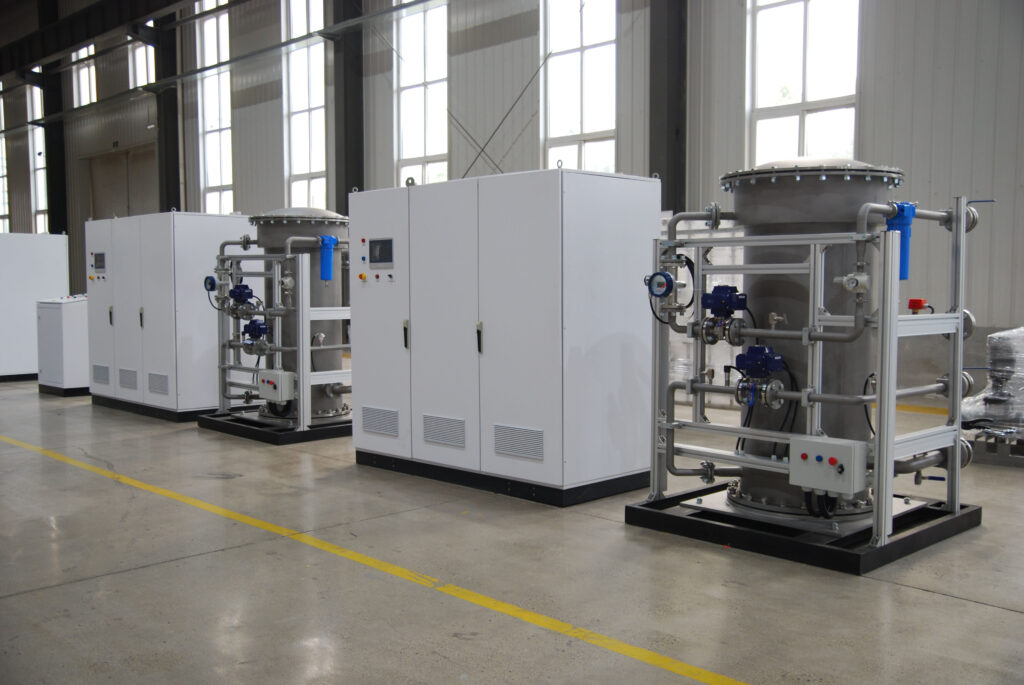According to the ways in which ozone is generated, there are currently three main types of ozone generators: high-voltage discharge, ultraviolet irradiation, and electrolysis.
High voltage discharge ozone generator
This type of ozone generator uses a certain frequency of high-voltage current to create a high-voltage corona electric field, causing electrochemical reactions of oxygen molecules inside or around the electric field, thereby producing ozone.
This type of ozone generator has advantages such as mature technology, stable operation, long service life, and large ozone production (up to 1Kg/h per unit), making it the most widely used ozone generator in related industries both domestically and internationally.

There are several types of high-voltage discharge ozone generators:
1. According to the high-voltage frequency of the ozone generators, there are three types: power frequency (50-60Hz), intermediate frequency (400-1000Hz), and high frequency (>1000Hz). Due to its large size and high power consumption, power frequency generators have basically been phased out of the market. Medium and high-frequency generators have the advantages of small size, low power consumption, and high ozone production, making them the most commonly used products nowadays.
- According to the gas raw materials used, there are two types: oxygen type and air type. Oxygen type is usually supplied by oxygen cylinders or oxygen concentrators. Air type usually uses clean and dry compressed air as the raw material. Due to the fact that ozone is generated by oxygen, and the oxygen content in the air is only 21%, the ozone concentration produced by air type generators is relatively low, while the oxygen purity of bottled or oxygen concentrators is above 90%, so the ozone concentration of oxygen type generators is higher.
- Divided by cooling method, there are water-cooled and air-cooled types. The ozone generator generates a large amount of heat energy during operation and requires cooling, otherwise ozone will decompose at the same time due to high temperature. The water-cooled generator has good cooling effect, stable operation, no ozone attenuation, and can work continuously for a long time, but its structure is complex and the cost is slightly higher. The cooling effect of the air-cooled type is not ideal, and the ozone attenuation is significant. High performance ozone generators with overall stable performance are usually water-cooled. Air cooling is generally only used for mid to low-end ozone generators with lower ozone production. When selecting a generator, it is advisable to choose a water-cooled type as much as possible.
- According to dielectric materials, common types include quartz tubes (a type of glass), ceramic plates, ceramic tubes, glass tubes, and enamel tubes. В настоящий момент, ozone generators made of various dielectric materials are available for sale in the market, with different performance. Glass dielectric materials have low cost and stable performance, making them one of the earliest materials used in artificial ozone production, but with poor mechanical strength. Ceramics are similar to glass, but ceramics are not suitable for processing, and their use in large ozone machines is limited. Enamel is a new type of dielectric material that integrates the dielectric and electrode, with high mechanical strength and precision machining. It is widely used in large and medium-sized ozone generators, but its manufacturing cost is high.
- According to the structure of ozone generators, there are two types: gap discharge (DBD) and open discharge. The structural characteristic of gap discharge type is that ozone is generated in the gaps between the inner and outer electrodes, and ozone can be collected and output in a concentrated manner with a high concentration, such as for water treatment. The electrodes of an open generator are exposed to the air, and the ozone produced directly diffuse.
 максимальный генератор озона
максимальный генератор озона
